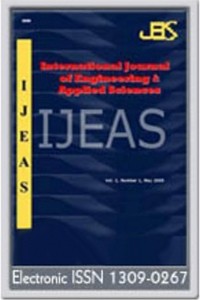Temperature Dependence of Single-Bubble Sonoluminences (SBSL)
This paper presents an experimental documentation of production of Single-bubble Sonoluminescence (SBSL) and its temperature dependence. The sonoluminescent bubble experiences continuous rapid contractions and expansions with precise regularity. The intensity of light emitted by bubble is depending on the bubble size. The main purposes of this research are to investigate the luminescence intensity and the maximum bubble size with variation of water temperature. In this study it has been observed that the luminescence intensity and the bubble size are inversely proportional to the water temperature. The size of the bubble was measured by Mie-scattering and light intensity measured by Photo-Multiplier Tube (PMT)
___
- 1].D.Felipe Ganiten, Lawrence A. Crum, Charles C. Church, and Ronald A.Roy. “Sonoluminescence and bubble dynamics for single, stable, cavitation bubble.” Journal of Acoustic Society of America,Vol. 91, No. 6. p.3166 (1992).
- [2].Lowrence A. Crum (1994). “Sonoluminescence” Physics Todoy, American Instituent of Physics.P .22 (1994).
- [3].L.D.Landau and E.M.Lifshitz, Courses of Theoretical Physics, Vol.6, Fluid Mechanics, 2nd Edition, Pergamon Press, Tokyo, Japan. (1987).
- [4].C.Ray Wylie, Advanced Engineering Mathematics, International Student Edition, McGraw-Hill Kogakusha, Ltd. Tokoy, Japan (1975).
- [5].Helen M. Walker and Joseph Lev, Elementary Statistical Methods, Third Edition, Holt, Rinehart and Winston, Inc. New York. (1969).
- [6].R.S. Burington and Donald Curtis May, Hand Book of Probability and Statistics with Tables,Handbook Publishers, Inc., Sandusky, Ohio.
- [7].B.S.Grew, Higher Engineering Mathematics, Thirty Fourth Edition, Third Print, Khanna Publishers (1999)
- Başlangıç: 2009
- Yayıncı: Akdeniz Üniversitesi
